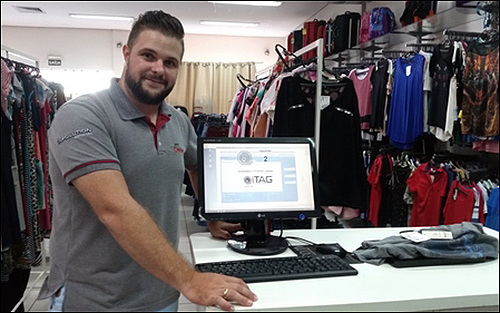Lojas Ki Barato, located in Ivaiporã, Brazil, reports that it has gained agility, flexibility, accuracy and quick decision-making capability thanks to its implementation of an RFID-based solution from iTag. According Hans Ricken, the technology manager of Grupo Center, which operates the retail chain, RFID allowed for a reduction in the interval between one inventory count and the next, in addition to providing greater inventory control, optimizing processes and reducing overtime costs. This, he says, freed up employees to devote more time to profitable activities.
Ricken says the RFID deployment’s success has opened the company’s eyes regarding what the next steps with the technology should be, including installing an RFID-based anti-theft system at store exits, thereby further guaranteeing the integrity of local stock levels. Thus, says Alcides Obermann, Grupo Center’s director, it will be possible to maintain the brand’s differentials from its competitors, which he says are quality and a fair price. After the implementation at Ivaiporã (which sells 5,000 items per month), the solution will be extended to the other stores in the chain.
The project’s biggest challenge has been to label all areas of the store within a week, which involved the placement of 32,000 new labels on goods. Team training was one of the most intense RFID deployment activities, Ricken says, “because it totally changed the labeling and sales routine, requiring great care with these new tags.”
To date, Ricken notes, the greatest gain has been the time savings from such processes as inventory counting, which has become much more efficient and speedy, decreasing the number of employees required. “Regarding the expectations, they were met,” he states, “but we are waiting for more from the next projects.”
The solution deployed at Lojas Ki Barato includes three middleware suites: iPrint, Monitor and Alert 2.0, all developed by iTag. IPrint is connected to a company’s enterprise resource planning (ERP) system, to perform label serialization. Monitor connects to the ERP to capture readings performed by Identix Rpad readers. And Alert 2.0, an application that runs on Android devices, can be paired with Zebra Technologies‘ RFD8500 device via a Bluetooth connection, in order to manage and inventory the store.
Prior to the RFID system’s deployment, products were labeled according to billing, but without control of serialization; the labels were printed only with bar codes. With RFID, tags are generated per request after billing. “By sending the labels for printing,” Ricken explains, “the EPC [Electronic Product Code] is linked to the merchandise stock, thus generating an ID for each item; no more labels can be printed than the quantity in stock.”
As product identification becomes unique, Ricken says, this reduces the chances of one item being labeled instead of another. It also eliminates the possibility of duplication, he adds, since each EPC corresponds to only a single item in stock. As such, Ricken maintains, there is no way to handle sales without the labels.
In the Brazil region, Ricken says, there is the custom of making so-called “conditional” sales, when a certain number of items are taken to a home or some other desired location, so that the customer can choose the parts he or she would like to keep. The customer then returns any parts he or she does not want.
“Using only the bar-code labels was necessary,” Ricken states, “to pass product by product in the reader, in order to realize this type of sale—a slow process and with a lot of risk for errors.” But with RFID, he says, just a single click is necessary to read items in large volumes—for example, half a dozen items at a time—via a table reader, without the possibility of item duplication or parts remaining hidden inside boxes.
Previously, Lojas Ki Barato performed inventory counts every 10 months or once a year, due to the number of employees needed for the slow, manual process, which required scheduling in advance. “Stock inventory could take 12 hours or more with a team of up to 20 people working on the manual counting of items,” Ricken says. “That is, items were read one by one by the bar-code reader. In the end, when a divergence report was printed, product searches were also done manually, and many items were not found.”
Each store has a significant and varied number of items in stock—around 30,000, Ricken says. “With RFID, we promote inventory with a shorter time and greater agility,” he states. “We have reduced the number of employees in our operations, and the need for very long scheduling. For inventory counting today, we use only four employees with two RFID readers.” The task now takes only an average of 5 hours to complete.
“Another advantage,” Ricken says, “is the possibility of loading the product database onto the readers, searching only for divergent items, and utilizing the locator function in the RFID collector. This eliminates manual searches, which greatly increases the success rate of the count, instead of generating holes in stock.”
Readers are installed at the point of sale, while others are deployed around the store. The reading is performed by Identix Rpad devices connected to computers via a USB cable. “For sales, we use Rpads, plus five readers and a Zebra data collector for inventory counting,” Ricken says. “We work with iTag’s 4124 model tamper-proof labels, which are not reused.”
“The success of an RFID project depends on how much insight an entrepreneur has into the needs of his market and his business,” says Sérgio Gambim, iTag’s CEO.




